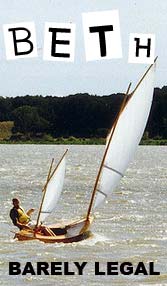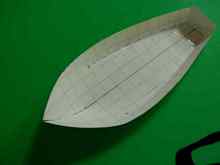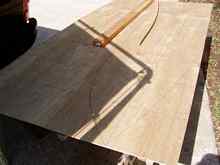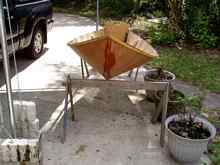While reading an article in DUCKWORKS about ONE SHEET CREATIONS by David Horst I was struck by his challenge to build a full size version of his one sheet boat. A sheet of Luan plywood is $12 at LOWE'S, I can risk that to satisfy my curiosity about bending plywood to the extreme.
Looking at David's plans showed the curves he formed to make his model so I had to make my own model and of course try something a little different. I used the full length of the 4x8 sheet, extending David's plan about a foot thinking I would use a piece of heavy plywood for a transom and gain some length in my skiff. I used his curves for the bow as close as I could figure them. The sides I carried straight back to the corners of the sheet. I found I could pull the bow together without a front transom and take the sides back to the corner of the plywood. The result was a dramatic model with pretty curves. This was the easy part.
Now the actual build. The layout was simple, use a grid of one foot squares and a thin batten to draw the curves. Luan plywood is easy to cut but watch out for splinters.
My first attempt to pull the bow together, "crack", even Luan plywood has trouble bending to the extreme. Not to waste $12, I quickly split the plywood down the middle and patched the rupture. 'This was an experiment, right.'
The two halves of the hull were then rejoined by cable ties to reform the boat. I flattened out the rear of the boat and screwed cross braces at the extreme end and 12" and 24" from the stern, this pulled the bow way up. I pulled the sides in to the stern and decided on a transom of 12" at the bottom expanding to 15" wide at the top of the sides. I had the sides at 9" height by David's plans. My transom is from 5/8 inch plywood and I made it 14" high at the center to take a cut out hand hold in the middle of the top.
I set the transom just in front of the back cross brace of the bottom. The transom was screwed in to the brace and the bottom. The sides were then screwed to the transom. This left about an inch of bottom and a half inch of side extending past the transom to be removed. The sides curved in over the bottom so the bottom had to be marked and cut to the curve. The sides and the bottom were then pulled together with cable ties. Much glue and epoxy was then applied everywhere. The cross bracing was removed and different bracing was applied.
Gunnels of 1/4"by 1/2" were glued on both inside and outside, to strength the luan we are using. The bottom joints were taped and epoxied and finally a layer of cloth and epoxy covered the bottom. I put corner braces on the transom and bow and added a floor of furring strips.
The result is a cool looking curvy boat, 88" overall length, 40" at the widest, a weight of 35 pounds. The boat is less stable then most one sheet boats but just as cute.
David, this is not your true plan but close, your plan might be better in performance and stability, thanks for the inspiration. |


















